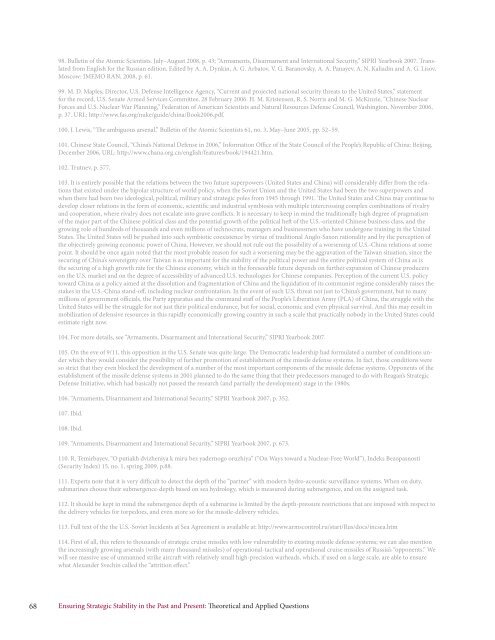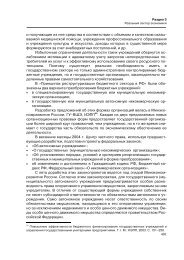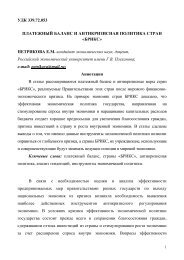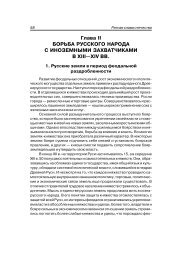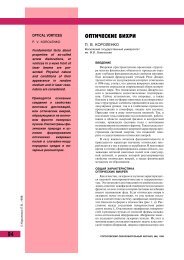Ensuring Strategic Stability in the Past and Present:
Ensuring Strategic Stability in the Past and Present:
Ensuring Strategic Stability in the Past and Present:
Create successful ePaper yourself
Turn your PDF publications into a flip-book with our unique Google optimized e-Paper software.
98. Bullet<strong>in</strong> of <strong>the</strong> Atomic Scientists. July–August 2008, p. 43; “Armaments, Disarmament <strong>and</strong> International Security,” SIPRI Yearbook 2007. Translatedfrom English for <strong>the</strong> Russian edition. Edited by A. A. Dynk<strong>in</strong>, A. G. Arbatov, V. G. Baranovsky, A. A. Panayev, A. N. Kaliad<strong>in</strong> <strong>and</strong> A. G. Lisov,Moscow: IMEMO RAN, 2008, p. 61.99. M. D. Maples, Director, U.S. Defense Intelligence Agency, “Current <strong>and</strong> projected national security threats to <strong>the</strong> United States,” statementfor <strong>the</strong> record, U.S. Senate Armed Services Committee, 28 February 2006. H. M. Kristensen, R. S. Norris <strong>and</strong> M. G. McK<strong>in</strong>zie, “Ch<strong>in</strong>ese NuclearForces <strong>and</strong> U.S. Nuclear War Plann<strong>in</strong>g,” Federation of American Scientists <strong>and</strong> Natural Resources Defense Council, Wash<strong>in</strong>gton, November 2006,p. 37. URL: http://www.fas.org/nuke/guide/ch<strong>in</strong>a/Book2006.pdf.100. J. Lewis, “The ambiguous arsenal,” Bullet<strong>in</strong> of <strong>the</strong> Atomic Scientists 61, no. 3, May–June 2005, pp. 52–59.101. Ch<strong>in</strong>ese State Council, “Ch<strong>in</strong>a’s National Defense <strong>in</strong> 2006,” Information Office of <strong>the</strong> State Council of <strong>the</strong> People’s Republic of Ch<strong>in</strong>a: Beij<strong>in</strong>g,December 2006, URL: http://www.chana.org.cn/english/features/book/194421.htm.102. Trutnev, p. 577.103. It is entirely possible that <strong>the</strong> relations between <strong>the</strong> two future superpowers (United States <strong>and</strong> Ch<strong>in</strong>a) will considerably differ from <strong>the</strong> relationsthat existed under <strong>the</strong> bipolar structure of world policy, when <strong>the</strong> Soviet Union <strong>and</strong> <strong>the</strong> United States had been <strong>the</strong> two superpowers <strong>and</strong>when <strong>the</strong>re had been two ideological, political, military <strong>and</strong> strategic poles from 1945 through 1991. The United States <strong>and</strong> Ch<strong>in</strong>a may cont<strong>in</strong>ue todevelop closer relations <strong>in</strong> <strong>the</strong> form of economic, scientific <strong>and</strong> <strong>in</strong>dustrial symbiosis with multiple <strong>in</strong>tercross<strong>in</strong>g complex comb<strong>in</strong>ations of rivalry<strong>and</strong> cooperation, where rivalry does not escalate <strong>in</strong>to grave conflicts. It is necessary to keep <strong>in</strong> m<strong>in</strong>d <strong>the</strong> traditionally high degree of pragmatismof <strong>the</strong> major part of <strong>the</strong> Ch<strong>in</strong>ese political class <strong>and</strong> <strong>the</strong> potential growth of <strong>the</strong> political heft of <strong>the</strong> U.S.-oriented Ch<strong>in</strong>ese bus<strong>in</strong>ess class, <strong>and</strong> <strong>the</strong>grow<strong>in</strong>g role of hundreds of thous<strong>and</strong>s <strong>and</strong> even millions of technocrats, managers <strong>and</strong> bus<strong>in</strong>essmen who have undergone tra<strong>in</strong><strong>in</strong>g <strong>in</strong> <strong>the</strong> UnitedStates. The United States will be pushed <strong>in</strong>to such symbiotic coexistence by virtue of traditional Anglo-Saxon rationality <strong>and</strong> by <strong>the</strong> perception of<strong>the</strong> objectively grow<strong>in</strong>g economic power of Ch<strong>in</strong>a. However, we should not rule out <strong>the</strong> possibility of a worsen<strong>in</strong>g of U.S.-Ch<strong>in</strong>a relations at somepo<strong>in</strong>t. It should be once aga<strong>in</strong> noted that <strong>the</strong> most probable reason for such a worsen<strong>in</strong>g may be <strong>the</strong> aggravation of <strong>the</strong> Taiwan situation, s<strong>in</strong>ce <strong>the</strong>secur<strong>in</strong>g of Ch<strong>in</strong>a’s sovereignty over Taiwan is as important for <strong>the</strong> stability of <strong>the</strong> political power <strong>and</strong> <strong>the</strong> entire political system of Ch<strong>in</strong>a as is<strong>the</strong> secur<strong>in</strong>g of a high growth rate for <strong>the</strong> Ch<strong>in</strong>ese economy, which <strong>in</strong> <strong>the</strong> foreseeable future depends on fur<strong>the</strong>r expansion of Ch<strong>in</strong>ese producerson <strong>the</strong> U.S. market <strong>and</strong> on <strong>the</strong> degree of accessibility of advanced U.S. technologies for Ch<strong>in</strong>ese companies. Perception of <strong>the</strong> current U.S. policytoward Ch<strong>in</strong>a as a policy aimed at <strong>the</strong> dissolution <strong>and</strong> fragmentation of Ch<strong>in</strong>a <strong>and</strong> <strong>the</strong> liquidation of its communist regime considerably raises <strong>the</strong>stakes <strong>in</strong> <strong>the</strong> U.S.-Ch<strong>in</strong>a st<strong>and</strong>-off, <strong>in</strong>clud<strong>in</strong>g nuclear confrontation. In <strong>the</strong> event of such U.S. threat not just to Ch<strong>in</strong>a’s government, but to manymillions of government officials, <strong>the</strong> Party apparatus <strong>and</strong> <strong>the</strong> comm<strong>and</strong> staff of <strong>the</strong> People’s Liberation Army (PLA) of Ch<strong>in</strong>a, <strong>the</strong> struggle with <strong>the</strong>United States will be <strong>the</strong> struggle for not just <strong>the</strong>ir political endurance, but for social, economic <strong>and</strong> even physical survival. And this may result <strong>in</strong>mobilization of defensive resources <strong>in</strong> this rapidly economically grow<strong>in</strong>g country <strong>in</strong> such a scale that practically nobody <strong>in</strong> <strong>the</strong> United States couldestimate right now.104. For more details, see “Armaments, Disarmament <strong>and</strong> International Security,” SIPRI Yearbook 2007.105. On <strong>the</strong> eve of 9/11, this opposition <strong>in</strong> <strong>the</strong> U.S. Senate was quite large. The Democratic leadership had formulated a number of conditions underwhich <strong>the</strong>y would consider <strong>the</strong> possibility of fur<strong>the</strong>r promotion of establishment of <strong>the</strong> missile defense systems. In fact, those conditions wereso strict that <strong>the</strong>y even blocked <strong>the</strong> development of a number of <strong>the</strong> most important components of <strong>the</strong> missile defense systems. Opponents of <strong>the</strong>establishment of <strong>the</strong> missile defense systems <strong>in</strong> 2001 planned to do <strong>the</strong> same th<strong>in</strong>g that <strong>the</strong>ir predecessors managed to do with Reagan’s <strong>Strategic</strong>Defense Initiative, which had basically not passed <strong>the</strong> research (<strong>and</strong> partially <strong>the</strong> development) stage <strong>in</strong> <strong>the</strong> 1980s.106. “Armaments, Disarmament <strong>and</strong> International Security,” SIPRI Yearbook 2007, p. 352.107. Ibid.108. Ibid.109. “Armaments, Disarmament <strong>and</strong> International Security,” SIPRI Yearbook 2007, p. 673.110. R. Temirbayev, “O putiakh dvizheniya k miru bez yadernogo oruzhiya” (“On Ways toward a Nuclear-Free World”), Indeks Bezopasnosti(Security Index) 15, no. 1, spr<strong>in</strong>g 2009, p.88.111. Experts note that it is very difficult to detect <strong>the</strong> depth of <strong>the</strong> “partner” with modern hydro-acoustic surveillance systems. When on duty,submar<strong>in</strong>es choose <strong>the</strong>ir submergence-depth based on sea hydrology, which is measured dur<strong>in</strong>g submergence, <strong>and</strong> on <strong>the</strong> assigned task.112. It should be kept <strong>in</strong> m<strong>in</strong>d <strong>the</strong> submergence depth of a submar<strong>in</strong>e is limited by <strong>the</strong> depth-pressure restrictions that are imposed with respect to<strong>the</strong> delivery vehicles for torpedoes, <strong>and</strong> even more so for <strong>the</strong> missile-delivery vehicles.113. Full text of <strong>the</strong> <strong>the</strong> U.S.-Soviet Incidents at Sea Agreement is available at: http://www.armscontrol.ru/start/Rus/docs/<strong>in</strong>csea.htm114. First of all, this refers to thous<strong>and</strong>s of strategic cruise missiles with low vulnerability to exist<strong>in</strong>g missile defense systems; we can also mention<strong>the</strong> <strong>in</strong>creas<strong>in</strong>gly grow<strong>in</strong>g arsenals (with many thous<strong>and</strong> missiles) of operational-tactical <strong>and</strong> operational cruise missiles of Russia’s “opponents.” Wewill see massive use of unmanned strike aircraft with relatively small high-precision warheads, which, if used on a large scale, are able to ensurewhat Alex<strong>and</strong>er Svech<strong>in</strong> called <strong>the</strong> “attrition effect.”68<strong>Ensur<strong>in</strong>g</strong> <strong>Strategic</strong> <strong>Stability</strong> <strong>in</strong> <strong>the</strong> <strong>Past</strong> <strong>and</strong> <strong>Present</strong>: Theoretical <strong>and</strong> Applied Questions


